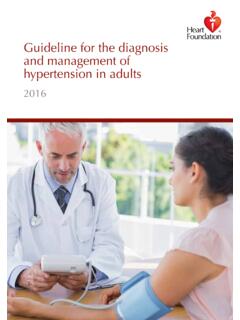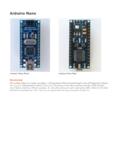Transcription of Definition of IoT(Internet of Things)
1 Definition of IoT(Internet of Things): The IoT can be defined in two ways based on existing Technology Infrastructure Definition of IoT based on existing technology: IoT is a new revolution to the internet due to the advancement in sensor networks, mobile devices, wireless communication, networking and cloud technologies. Definition of IoT based on infrastructure: IoT is a dynamic global network infrastructure of physical and virtual objects having unique identities, which are embedded with software, sensors, actuators, electronic and network connectivity to facilitate intelligent applications by collecting and exchanging data.
2 Goal of IoT: The main goal of IoT is to configure, control and network the devices or things, to internet, which are traditionally not associated with the internet thermostats, utility meters, a Bluetooth connected headset, irrigation pumps and sensors or control circuits for an electric car s engine that make energy, logistics, industrial control, retail, agriculture and many other domain smarter. Characteristics of IoT: Various characteristics of IoT are: Dynamic and self-adapting Self-configuring Interoperable Communication protocols Unique identity Integrated into information network Dynamic and self-adapting: The IoT devices can dynamically adapt with sensed environment, their operating conditions, and user s context and take actions accordingly.
3 For ex: Surveillance System. Self-configuring: I. IoT devices can be able to upgrade the software with minimal intervention of user, whenever they are connected to the internet. II. They can also setup the network a new device can be easily added to the existing network. For ex: Whenever there will be free wifi access one device can be connected easily. Interoperable Communication: IoT allows different devices (different in architecture) to communicate with each other as well as with different network. For ex: MI Phone is able to control the smart AC and smart TV of different manufacturer. Unique identities: I.
4 The devices which are connected to the internet have unique identities IP address through which they can be identified throughout the network. II. The IoT devices have intelligent interfaces which allow communicating with users. It adapts to the environmental contexts. III. It also allows the user to query the devices, monitor their status, and control them remotely, in association with the control, configuration and management infrastructure. Integrated into information network: I. The IoT devices are connected to the network to share some information with other connected devices. The devices can be discovered dynamically in the network by other devices.
5 For ex. If a device has wifi connectivity then that will be shown to other nearby devices having wifi connectivity. II. The devices ssid will be visible though out the network. Due to these things the network is also called as information network. III. The IoT devices become smarter due to the collective intelligence of the individual devices in collaboration with the information network. For Ex: weather monitoring system. Here the information collected from different monitoring nodes (sensors, arduino devices) can be aggregated and analysed to predict the weather. Physical Design of IoT: Things in IoT: I.
6 IoT Internet of things, where things refer to the IoT devices which have unique identities and can perform remote sensing, actuating and monitoring capabilities (ex: combination of sensors, actuators, arduino , relay, non IoT devices). II. The IoT devices can share information with as well as collect information from other connected devices and applications (directly and indirectly). III. They can process the data locally or in the cloud to find greater insights and put them into action based on temporal and space constraints ( space memory, processing capabilities, communication latencies and speeds and deadlines). IV. IoT devices can be of varied types.
7 For ex: wearable sensors, smart watches, LED lights, automobiles and industrial machines. Logical design of IoT: Logical design of IoT refers to an abstract representation of entities and the processes without going into the details of the implementations. The logical design includes functional block of IoT and the communication APIs. IoT functional Block: (Refer book for the diagram): The functional block of the system provides the capabilities for identification, sensing, actuation, communication and management. Various components of IoT functional block are as follows. Device Communications Services Management Security Application Device: I.
8 IoT Internet of things, where things refer to the IoT devices which have unique identities and can perform remote sensing, actuating and monitoring capabilities (ex: combination of sensors, actuators, arduino , relay, non IoT devices). II. The IoT devices can share information with as well as collect information from other connected devices and applications (directly and indirectly). III. They can process the data locally or in the cloud to find greater insights and put them into action based on temporal and space constraints ( space memory, processing capabilities, communication latencies and speeds and deadlines). IV. IoT devices can be of varied types.
9 For ex: wearable sensors, smart watches, LED lights, automobiles and industrial machines. Communications: It refers to various communication protocols which allows different devices to communicate with each other by sharing some information. It also allows interoperability among different devices. Services: IoT system provides various services such as device monitoring, device control services, data publishing services, device discovery services. Management: Various management functions to govern the IoT system. Security: It secures the IoT system by providing authentication, authorization, message and content integrity and data security.
10 Application: I. IoT applications provide an interface that the users can use to control and monitor various aspects of the IoT system. II. It also allows viewing the system status and view or analysing the processed data. IoT communication model: To provide communication to various IoT devices, there are various communication models. Such as Request-Response communication model Publisher-subscriber communication model Push-pull communication model Exclusive-pair communication model Request-response communication model: (Refer book for the diagram) I. In this communication model client will send request to server. Server will receive the request then decides how to respond, fetches the data according to client s request, retrieves resource representations, prepares the response and then sends the response to client.






